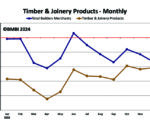Construction growth reaches four-month high in November
 November data pointed to a solid expansion of UK construction output, which was supported by a broad-based upturn in the three sub-categories of activity monitored by the survey. Growth of new work picked up since October and rising client demand underpinned a robust and accelerated expansion of employment. The rate of job creation was the fastest since December 2015. However, business confidence remained relatively subdued, with survey respondents noting that Brexit-related concerns had weighed on their growth projections for the next 12 months.
November data pointed to a solid expansion of UK construction output, which was supported by a broad-based upturn in the three sub-categories of activity monitored by the survey. Growth of new work picked up since October and rising client demand underpinned a robust and accelerated expansion of employment. The rate of job creation was the fastest since December 2015. However, business confidence remained relatively subdued, with survey respondents noting that Brexit-related concerns had weighed on their growth projections for the next 12 months.
The seasonally adjusted IHS Markit/CIPS UK Construction Total Activity Index registered 53.4 in November, up from 53.2 in October, to remain above the crucial 50.0 no-change mark for the eighth successive month. Moreover, the latest reading signalled the strongest rate of business activity expansion since July.
Residential building reclaimed its position as the fastest growing area of construction work in November. The latest rise in house building activity was the strongest for three months. Latest data also pointed to sustained increases in commercial work and civil engineering activity.
Survey respondents noted that rising client demand continued to boost construction output during November. The rate of new business growth picked up since October, but remained softer than seen on average in the third quarter of 2018. Some construction firms noted that Brexit uncertainty had held back new order growth, while there were also reports citing delays to public sector spending decisions.
Higher levels of new business contributed to a solid expansion of input buying and rising employment numbers during November. The latest increase in staffing levels was the fastest since December 2015. Meanwhile, greater demand for construction products and materials contributed to worsening vendor performance. Longer delivery times from suppliers have been reported in each month since September 2010.
Growing demand for construction inputs led to another sharp rise in input prices during November. Survey respondents also commented on higher transportation costs and rising staff salaries. The overall rate of input price inflation was the fastest since June.
Meanwhile, latest data indicated that business optimism across the construction sector rebounded from the near six-year low seen in October. The latest reading signalled the strongest degree of confidence for three months. Anecdotal evidence suggested that Brexit-related concerns remained the main factor weighing on business optimism during November.
Tim Moore, Economics Associate Director at IHS Markit, which compiles the survey: “November data indicates that the UK construction sector remains in expansion mode, with resilient business activity trends seen for housing, commercial and civil engineering activity. The latest overall rise in construction output was the fastest since July, helped by a stronger contribution to growth from house building activity.
“Higher levels of new work were recorded for the sixth month running in November, which resulted in a robustand accelerated rise in staffing numbers. The latestupturn in employment was the fastest for almost threeyears. A number of construction firms noted that greater demand for staff had led to upward pressure on salariesin November.
“Business confidence regarding the year ahead outlookfor construction work picked up from October’s recent low, but remained weaker than seen on average in thefirst half of 2018. Survey respondents widely commentedthat Brexit-related uncertainty had held back business optimism in November.”
Duncan Brock, Group Director at the Chartered Institute of Procurement & Supply: “After last month’s disappointing levels of businessoptimism, the construction sector perked up marginally in November. There was good activity across all the sub- sectors and residential building reclaimed its leader of the pack status with the strongest performance of all three.
“Levels of new work improved, and employment numbers increased at their fastest rate since December2015, as projects finally started after sustained periodsof delay. But before the champagne corks start popping, this rise in the overall index was small. Even with optimism at a three-month high, there is currently no indication that this will become a sustained rise as we approach the end of the year.
“Constrained supply chains were still underperforming as supplier operations worsened again and to theirweakest level for three months. Suppliers reduced theirstock levels and reports of raw material shortagesgnawed away at efficiency. Adding to this challengingmix, prices for raw materials continued their strongupward trajectory, so the pathway ahead is still far fromclear of blockages, Brexit-related or otherwise.”











